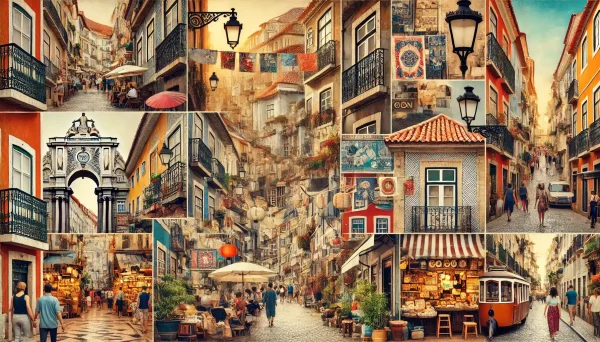In a world where modern skyscrapers and rapid urban development dominate skylines, some neighborhoods have held on tightly to their roots. These historic districts serve as living time capsules, preserving not only architecture but also the culture, traditions, and daily rhythms of earlier eras. Walking through these neighborhoods feels like stepping into a storybook, where cobblestone streets, vintage façades, and generations-old businesses continue to thrive. These are the places where the soul of a city is most visible—where the past still speaks through every brick and balcony.
1. Alfama – Lisbon, Portugal
Alfama is one of the oldest neighborhoods in Lisbon, and its charm lies in its maze-like streets, ancient houses, and echoes of fado music pouring from tiny taverns. Built on a hill beneath the São Jorge Castle, Alfama survived the 1755 earthquake that destroyed much of Lisbon. Today, it remains a vibrant blend of tradition and resilience, where laundry hangs from windows and the scent of grilled sardines fills the air.
2. Montmartre – Paris, France
Famous for its bohemian spirit and artistic legacy, Montmartre was once the home of legends like Picasso, Van Gogh, and Toulouse-Lautrec. Perched on a hill with winding lanes and charming cafés, it retains the feel of 19th-century Paris. The Basilica of Sacré-Cœur watches over the neighborhood, and local bakeries and art studios preserve the creative energy that defined an era.
3. San Telmo – Buenos Aires, Argentina
San Telmo is the heart of tango and antique culture in Buenos Aires. Its colonial buildings, traditional cafés, and cobbled streets reflect Argentina’s rich heritage. On Sundays, the San Telmo Market attracts visitors with vintage items, street performers, and live music. Despite modernization, the neighborhood remains fiercely proud of its identity, offering a glimpse into the city’s soul.
4. Trastevere – Rome, Italy
Across the Tiber River from the hustle of central Rome lies Trastevere, a neighborhood that still feels like ancient Rome. With ivy-covered walls, terracotta rooftops, and narrow alleys, it’s a place where time moves slower. Locals gather in piazzas, artisans keep old crafts alive, and trattorias serve recipes passed down for generations. Trastevere preserves not just architecture but a way of life.
5. Gion – Kyoto, Japan
Gion is Kyoto’s most famous geisha district, where traditional tea houses, wooden machiya houses, and lantern-lit streets reflect the elegance of old Japan. Here, it’s still possible to catch a glimpse of a geiko or maiko (apprentice geisha) gracefully walking to an evening engagement. The neighborhood honors centuries-old rituals and aesthetics, offering a rare window into Japan’s cultural heritage.
6. Old Havana – Havana, Cuba
A UNESCO World Heritage Site, Old Havana is a stunning showcase of Spanish colonial architecture, vibrant plazas, and vintage cars. Despite years of economic hardship, the neighborhood pulses with color and rhythm. Restoration projects have helped revive its historic buildings, while local residents keep Cuban music, cuisine, and street life alive with pride and passion.
7. Gamla Stan – Stockholm, Sweden
Gamla Stan, or “Old Town,” is the birthplace of Stockholm. Its medieval streets, colorful buildings, and royal palaces transport visitors back to the 13th century. The narrow alleyways and cobblestones have witnessed centuries of Swedish history. Today, it remains a lively area filled with small shops, cozy restaurants, and deep Scandinavian character.
8. Jaffa – Tel Aviv, Israel
Jaffa is one of the oldest port cities in the world and a beautifully preserved district in modern Tel Aviv. Its ancient stone buildings, winding alleys, and art galleries form a unique blend of old and new. With views of the Mediterranean and a rich mix of Jewish, Muslim, and Christian heritage, Jaffa stands as a powerful symbol of cultural coexistence and endurance.
9. Georgetown – Washington, D.C., USA
Georgetown predates the founding of the U.S. capital and is known for its Federal-style architecture, gas-lit streets, and waterfront charm. Once a port town, it has preserved its historic homes, cobbled sidewalks, and iconic row houses. Despite being in a bustling capital, Georgetown maintains a quiet elegance and deep connection to American history.
10. Essaouira Medina – Essaouira, Morocco
The walled medina of Essaouira, on Morocco’s Atlantic coast, is a blend of Berber, Arab, and European influences. With its blue-and-white buildings, artisan markets, and centuries-old fortifications, the town preserves its multicultural past. The sea breeze and scent of spices fill the air, as musicians and craftsmen continue traditions passed down for generations.
Conclusion: Preserving the Pulse of the Past
Historic neighborhoods are more than tourist attractions—they are guardians of memory, community, and identity. While the modern world rushes forward, these districts remind us of our roots and the stories that shaped us. They deserve to be protected and celebrated not just for their beauty, but for the living history they represent. When we walk their streets, we don’t just travel through space—we travel through time.






